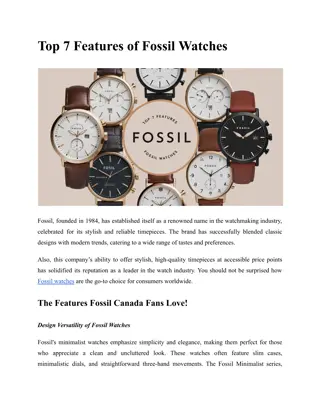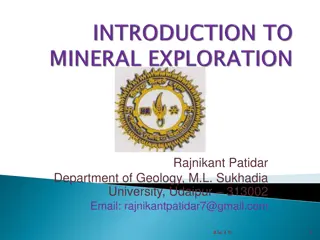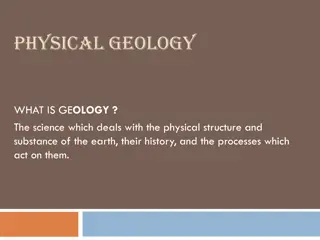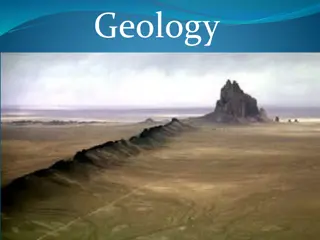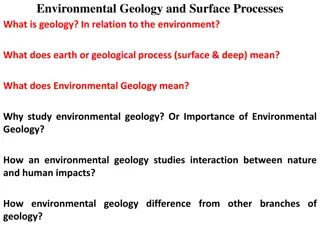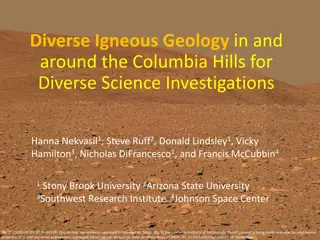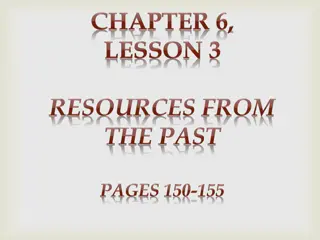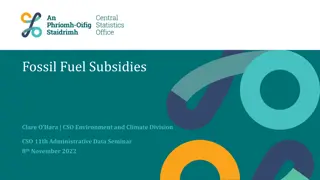Understanding Fossil Diversity in Geology Labs
Explore the world of fossils and geological time scales in a Geology for Non-Science Majors lab under Dr. Kate Bulinski at Bellarmine University. Understand major paleontological events, diversifications, mass extinctions, and groups of organisms while learning to graph in Microsoft Excel.
Download Presentation

Please find below an Image/Link to download the presentation.
The content on the website is provided AS IS for your information and personal use only. It may not be sold, licensed, or shared on other websites without obtaining consent from the author. Download presentation by click this link. If you encounter any issues during the download, it is possible that the publisher has removed the file from their server.
E N D
Presentation Transcript
Range-Through Chart and Diversity Curve Lab Dr. Kate Bulinski Bellarmine University
Geology for Non-Science Majors Meets for 2 hours twice a week First hour lecture, second hour lab Lab reinforces concepts introduced in lecture Limited to 20 students Students work in groups of 3-4
Objectives of Lab Reinforce knowledge about major paleontological events Diversifications Mass Extinctions Increase familiarity with the geological time scale Increase familiarity with major groups of organisms Implement the use of Microsoft Excel for graphing
Next: Sample Lecture Slides
Fossil Diversity Through Time The Jack Sepkoski Curve
Precambrian -3.8 billion years ago, earliest evidence of life -First fossils, 3.4 billion years ago Stromatolites
Cambrian Explosion -Major diversification of muticellular life -Many bizarre animals that went extinct
Ordovician Radiation -Second major diversification
Lab Components: Understanding the concept of Range Time of Origination Time of Extinction Persists throughout interval even if not found consistently Difference between fossil record and biological record
Linking Names to Fossils Previous knowledge obtained from systematics lab can be reinforced here: Students must correctly identify hand specimens to pair times of origination and extinction with names of fossil groups
Geological Time Scale (modified from geology.com) Range Through Chart Plotting Ranges Carboniferous Write Taxon Names Here
Geological Time Scale (modified from geology.com) Range Through Chart Plotting Ranges Fossil 1 Class Edrioasteroidea Range: Cambrian-Permian Fossil 2 Class Articulata Fossil 3 Subclass Ammonoidea Range: Silurian-Cretaceous Fossil 4 OrderRugosa Range: Ordovician-Permian Fossil 5 OrderTabulata Fossil 6 Class Blastoidea Fossil 7 Class Rostroconchia Range: Cambrian-Permian Fossil 8 Class Gastropoda Fossil 9 Class Stenolaemata Fossil 10 Class Trilobita Fossil 11 OrderScleractinia Fossil 12: Class Crinoidea Fossil 13 Class Echinoidea Fossil 14 Class Bivalvia Fossil 15 Subclass Nautiloidea Range: Cambrian- Recent Fossil 16 Class Stromatoporata Range: Ordovician-Cretaceous Fossil 17 Class Eurypterida Range: Cambrian-Permian Fossil 18 Class Graptolithina Range: Cambrian-Carboniferous Fossil 19 Class Conodonta Range: Cambrian-Triassic Fossil 20: Class Insecta Range: Silurian-Recent Range: Cambrian- Recent Range: Ordovician-Permian Range: Ordovician-Permian Range: Cambrian- Recent Range: Ordovician-Recent Range: Cambrian-Permian Range: Triassic- Recent Range: Ordovician- Recent Range: Ordovician-Recent Range: Cambrian-Recent Carboniferous Write Taxon Names Here
Geological Time Scale (modified from geology.com) Range Through Chart Plotting Ranges Fossil 1 Class Edrioasteroidea Range: Cambrian-Permian Fossil 2 Class Articulata Range: Cambrian- Recent Fossil 3 Subclass Ammonoidea Range: Silurian-Cretaceous Fossil 4 OrderRugosa Range: Ordovician-Permian Fossil 5 OrderTabulata Range: Ordovician-Permian Fossil 6 Class Blastoidea Range: Ordovician-Permian Fossil 7 Class Rostroconchia Range: Cambrian-Permian Fossil 8 Class Gastropoda Range: Cambrian- Recent Fossil 9 Class Stenolaemata Range: Ordovician-Recent Fossil 10 Class Trilobita Range: Cambrian-Permian Fossil 11 OrderScleractinia Range: Triassic- Recent Fossil 12: Class Crinoidea Range: Ordovician- Recent Fossil 13 Class Echinoidea Range: Ordovician-Recent Fossil 14 Class Bivalvia Range: Cambrian-Recent Fossil 15 Subclass Nautiloidea Range: Cambrian- Recent Fossil 16 Class Stromatoporata Range: Ordovician-Cretaceous Fossil 17 Class Eurypterida Range: Cambrian-Permian Fossil 18 Class Graptolithina Range: Cambrian-Carboniferous Fossil 19 Class Conodonta Range: Cambrian-Triassic Fossil 20: Class Insecta Range: Silurian-Recent Carboniferous Write Taxon Names Here
Constructing Diversity Curve Tally up the number of genera present in a period Extant Genera 11 17 19 19 19 18 12 11 11 9 9 Cambrian Ordovician Silurian Devonian Carboniferous Permian Triassic Jurassic Cretaceous Cenozoic Recent
Extant Genera Diversity Curve Cambrian 11 Ordovician 17 Silurian 19 Devonian 19 Carboniferous 19 Permian 18 20 Triassic 12 18 Jurassic 11 16 Cretaceous 11 Number of Taxa Cenozoic 9 14 Recent 9 12 10 8 6 4 2 0 Cambrian Ordovician Silurian Devonian Carboniferous Permian Triassic Jurassic Cretaceous Cenozoic Recent Geologic Time Labled at Ends of Periods
Discussion and Short-Answer Lab Questions 1) Based on the range chart you constructed, when does the largest extinction event occur and how many of the twenty organisms go extinct then? 2) What caused this extinction? 3) Which major extinction caused ammonoids to go extinct? What caused this extinction? 4) During what geological period do the most taxa originate and what is the name of this origination event? 5) During what geological period to the second largest number of taxa originate and what is the name of this event?
Discussion and Short-Answer Lab Questions 6) Notice when the three orders of coral originate and go extinct. Explain in a few sentences what the fossil record of corals looks like. 7) How many of the 20 taxa are extant today? 8) Provide three similarities and three differences between the diversity curve you generated and the Sepkoski Curve. Why are they different? 9) If you constructed a range through chart of fossil genera, would you expect their ranges in the fossil record to be longer or shorter? Why? 10) Why do you not find many fossils in the rock record before the Cambrian?
Potential Modifications For intro-level students: Use specific taxonomic group to construct a diversity curve (e.g., genera within Class Bivalvia) Genera of fossils found within a given rock interval Index fossils vs. non-index fossils
Potential Modifications For upper-level students: -each group or individual is assigned a class of organisms and must construct a genus-level diversity curve for comparison with other groups -students will determine genus ranges using the Paleobiology Database (www.paleodb.org) -provide guidelines for: -number of genera to include -resolution of the geological time scale (i.e., epochs vs. periods vs. PaleoDB 10my time bins)








